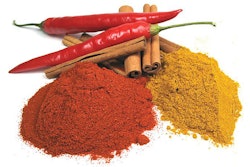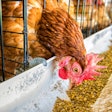
Most diets for poultry worldwide are composed of about 70 percent corn or wheat, 20 percent soybean meal and 10 percent other ingredients, such as minerals, vitamins and additives. Clearly this is an over-simplification because there is a whole science behind feed formulation using a myriad of ingredients and dietary specifications. Nevertheless, this “model” feed formula provides a simple visual aid to illustrate the point that the majority of poultry meat and eggs are produced using a rather limited range of major ingredients.
In the last twenty years, feed ingredient prices have fluctuated dramatically with detrimental effects on farming profitability as farming expenses are not always passed down to the consumer. There are several reasons for this upheaval in the otherwise stable trade of feed commodities, one of which having been the diversion of huge quantities of cereals towards production of bio-ethanol. Similarly, huge expanses of oil producing legume crops have been “sacrificed” to produce biodiesel. Thus, energy from cereals and oil-producing crops has been denied to animal farming, increasing prices, and leaving behind a mountain of protein, fiber, ash and every possible other nutrient and even contaminant in a concentrated form. To combat this eventuality, nutritionists can only find indirect ways to incorporate large quantities of “waste” or co-products, but there is always a limit — that of anti-nutritional factors.
The three most expensive nutrients, in absolute terms, in animal feeds are energy, protein and phosphorus. Animals derive these nutrients from their feed by the process of digestion, through secretion of endogenous enzymes and then the absorption of these nutrients from the gastrointestinal tract. Improving digestibility of these nutrients is the most obvious way of improving the net benefit animals obtain from their feed. And one of the ways to achieve this goal has been the use of enzymes added in feed. This has been proven beneficial in most cases, bringing about 5 percent improvement in feed efficiency.
Initial controlled assays and further commercial trials have demonstrated that some proteases can reduce feed cost by about 2 to 5 percent.
Today there are three major classes of enzymes, each aiming to improve digestibility of one of the three most expensive nutrients as described above. We shall next examine each in a bit more detail.
1. Energy and NSP enzymes (xylanases and beta-glucanases)
Cereals and protein sources, such as soybean meal, contain a significant amount of fiber, including non-starch polysaccharides (NSP) that are mostly non-digestible. In fact, a typical diet contains about 13 percent fiber matter that is simply excreted in the environment, although some fermentation of limited value occurs in the large intestine. The easiest class of fibers to attack with enzymes for poultry are NSP because cellulose and pectins/gums appear to be resistant to existing commercial enzymes (for now, at least.) Thus, improving digestibility of NSP has been shown to provide extra energy in poultry, to the value of about 50 kcal metabolizable energy per kilogram feed, which is roughly 2 to 3 percent of total dietary metabolizable energy concentration.
Read more: Understanding enzyme production is key to meeting feed needs
However, NSP enzymes may also liberate potentially significant concentrations of protein and minerals that are often compounded with or trapped by the NSP molecules, conferring further significant benefits. A significant, but often overlooked, effect in poultry is that NSP enzymes often reduce gut viscosity (most NSP are by nature of a "sticky" essence), which has been shown to improve overall litter quality in birds raised on floors, including reduced incidences of "dirty" eggs. The only problem with NSP enzymes is that natural ingredients often have low concentrations of NSP (for a number of good reasons), and in this instance, using NSP enzymes appears to be simply a waste of money on an additive that is apparently ineffective.
2. Protein and proteases
Up to very recently, there were no dedicated enzymes to aid protein digestion. Instead, this activity was claimed as a side effect in several commercial NSP enzyme cocktails. As such, proteases were of limited, even questionable, value. In 2009-10, the first sole-purpose protease was introduced in the market, only to be followed by other similar products. Their use remains less widespread than that of NSP enzymes. Initial controlled assays and further commercial trials have demonstrated that some proteases can reduce feed cost by about 2 to 5 percent, after accounting for the cost of the enzyme, or improve broiler performance by up to 4 to 6 percent in cases of diets with unbalanced protein profile. Today there is an oversupply of protein sources, and the use of proteases remains dependent on the price of commercial protein commodities. Perhaps improved (next generation) proteases will offer more significant benefits that will confer them more power against low protein commodities pricing.
3. Phosphorus and phytases
Phosphorus digestion has a field of much activity in the last twenty years, and many successful phosphorus enzymes (phytases) have been produced and marketed for quite some time now. In brief, a phytase degrades phytate of vegetable origin (a form of non-digestible phosphorus). It can improve phosphorus digestibility by about 10 percent, and as calcium is also bound in the same phytate molecule, it also improves calcium digestibility about 10 to 20 percent. Limited and quite often disputable research has also demonstrated that it may as well improve digestibility of other nutrients bound to phytate, such as protein and trace minerals. The net result of a phytase is, of course, reduction of excreted phosphorus, which can range up to 30 percent. In recent times, when inorganic phosphorus sources, such as mono- and dicalcium phosphate that are commonly added in most animal diets, have become so expensive, the use of a phytase grants substantial financial incentives to the user.
Future enzyme needs
We need enzymes to attack the remaining fiber components, others to improve digestibility of hard-to-digest lipid containing ingredients and, of course, better versions of existing products. Finally, it would not be a bad idea to find enzymes that could potentially destroy certain anti-nutritional factors in soybeans and other protein-rich ingredients, making the use of raw whole-protein seeds a reality. Major enzyme companies work on several of the above ideas, and we should be able to see new products emerge in the foreseeable future.
















